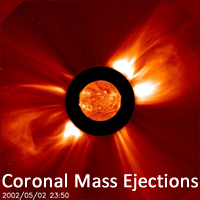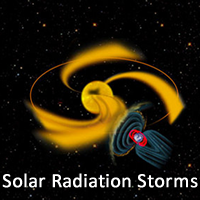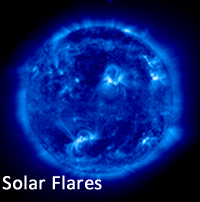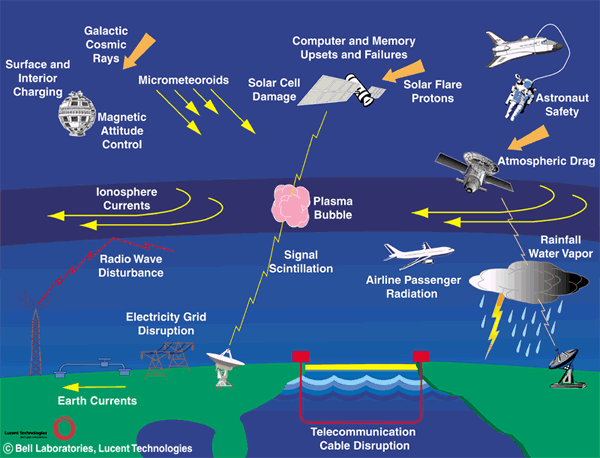
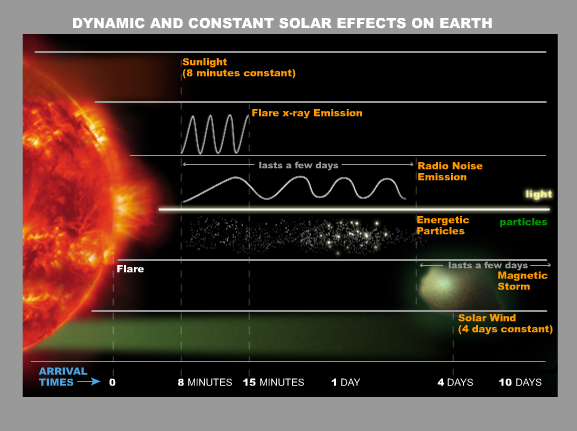 Nearly all of our space weather starts at the Sun. The image to the right illustrates the travel time for various phenomena that result in impacts to the Earth.Click here if you would like to review videos from the SWPC on some of the topics and impacts covered in this course.
Nearly all of our space weather starts at the Sun. The image to the right illustrates the travel time for various phenomena that result in impacts to the Earth.Click here if you would like to review videos from the SWPC on some of the topics and impacts covered in this course.
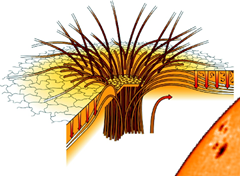
Sunpots are dark, cooler areas on the solar surface that contain strong, constantly shifting magnetic fields. A moderate-sized sunspot is many times larger than the size of the Earth. Click here to review the NASA video on sunspots.
Space weather can be discussed as...
| Phenomena |
|
|
|
Definition/ description |
... a cloud of plasma, or superheated gas, being blasted away from the Sun at anywhere from roughly 1 to 5 million miles per hour |
...eruptions of charged particles, i.e. protons and electrons, from the Sun which predominately follow the prevailing interplanetary magnetic fields (the pinwheel effect). |
… an eruption of radio emissions from the Sun which appears to be a very bright spot and a gaseous surface eruption which occur abruptly and with little warning. |
Timing from Sun to Earth |
17-96 hours |
10-30 minutes |
8 minutes |
| Agents | Energetic Charged Particles from the solar wind, coronal mass ejections and coronal holes. | Solar Flares and CMEs | Solar Flares and radio bursts |
Impact to Earth’s Atmosphere |
The impact of the material hurled at Earth impacts and distorts the Earth’s magnetosphere. This distortion creates magnetic field fluctuations that create induced currents in the atmosphere and on the ground. |
The charged particles interact with the atmosphere to help increase the density of the ionosphere. |
The impacts of these radio waves can heat the Earth’s atmosphere and create a layer known as the ionosphere. |
Impacts to Human Life |
The induced currents can cause issues with long power lines and pipelines, while the particles themselves can damage satellites. |
Risks include blackout of high frequency radio communications near the polar regions, and possible increase in radiation risks to astronauts and high altitude polar routes. Satellites may experience bit flops that may result in memory loss as well as cause spurious signals to send false commands. |
Impacts include degradation or impairment of GPS & HF Communications. |
Impacts of Space Weather include...
(Image courtesy of NASA - Click image to view source.)
There are 4 types of Space Weather Alert Messages
- Watch messages, for Geomagnetic A-indices, are issued for long-lead geomagnetic activity predictions.
- Warning messages are issued when some condition is expected. The messages contain a warning period and other information of interest.
- Alert messages are issued when an event threshold is crossed and contain information that is available at the time of issue.
- Summary messages are issued after the event ends, and contain additional information available at the time of issue.
Remember to advise callers to visit spaceweather.gov for more information.
Specific user groups can find information more tailored to their needs in their unique dashboard.
Congratulations. You reached the end of the course material!
Now that you have completed the review of the course material, please log into the LMS to complete the course assessment. You will not receive credit for the course until the LMS assessment is completed!
Once you have viewed the course summary, click here to view your normal page navigation.
